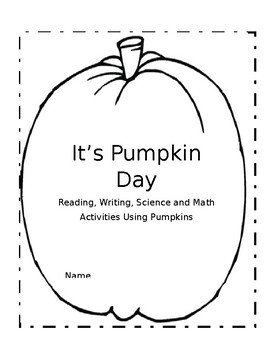It's Pumpkin Day- A Cross-Curricular Packet
Jan Wiggs
84 Followers
Description
Grab some of those awesome autumn pumpkins and pile them in your classroom during October or November, then enjoy some exciting cross-curricular learning fun! This packet combines reading, writing, science, and math into a full day of Pumpkin activities. Students can read the provided informational text or can use the provided digital texts options from Readworks.com or Epicbooks.com to learn about the anatomy of a pumpkin and its life cycle. Children then proceed to use the text evidence to retell what they read using their own words and writing skills. As the day continues, students use their math skills to measure, weigh, estimate, count, and compare features of their pumpkin. Depending on when this is used, there is a math page in which the children create a picture graph of face carving (October) or favorite pumpkin foods (November). Finally, have the children use their science skills of observation and recording to study the outside and inside of the pumpkin. While the children are having fun learning with their pumpkins, you are teaching 14 Common Core/Next Generation Standards. Enjoy...It's Pumpkin Day!
Total Pages
10 pages
Answer Key
N/A
Teaching Duration
Other
Last updated Oct 29th, 2017
Report this resource to TPT
Reported resources will be reviewed by our team. Report this resource to let us know if this resource violates TPT’s content guidelines.
Standards
to see state-specific standards (only available in the US).
CCSS2.MD.A.1
Measure the length of an object by selecting and using appropriate tools such as rulers, yardsticks, meter sticks, and measuring tapes.
CCSS2.MD.A.2
Measure the length of an object twice, using length units of different lengths for the two measurements; describe how the two measurements relate to the size of the unit chosen.
CCSS2.MD.D.10
Draw a picture graph and a bar graph (with single-unit scale) to represent a data set with up to four categories. Solve simple put-together, take-apart, and compare problems using information presented in a bar graph.
CCSS2.NBT.A.2
Count within 1000; skip-count by 5s, 10s, and 100s.
CCSS2.NBT.A.4
Compare two three-digit numbers based on meanings of the hundreds, tens, and ones digits, using >, =, and < symbols to record the results of comparisons.





